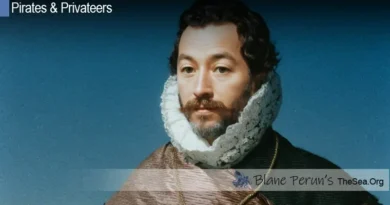Peter Easton
Peter Easton: The Notorious Pirate of the Newfoundland
Peter Easton, a name synonymous with piracy in the early 17th century, has been a subject of intrigue and historical study. Often overshadowed by his contemporaries like Blackbeard and Calico Jack, Easton’s impact on the seafaring world, especially around Newfoundland, was significant. This article delves into the life and legacy of Peter Easton, exploring his transformation from a privateer to one of the most feared pirates of his time.
Early Life and Privateering Beginnings
The Advent of a Seafarer
The journey of Peter Easton begins in the late 16th century. Born into a world where sea expeditions were the pinnacle of adventure and discovery, Easton quickly found his calling on the waves. His early life, shrouded in mystery, was the foundation for his later exploits. He emerged as a skilled navigator and tactician, essential skills that would later aid his piratical career.
From Royal Service to Piracy
Initially, Easton was a privateer under the English crown, a legitimate position during times of war. His privateering license, essentially a government-sanctioned piracy permit, allowed him to attack and plunder enemy ships, primarily the Spanish and the French. However, the end of the Anglo-Spanish War in 1604 left Easton and his crew unemployed, pushing them towards outright piracy.
Mastery of the North Atlantic
Establishing a Pirate Haven
Newfoundland, with its rich fishing grounds and strategic location, became the center of Easton’s operations. He transformed Harbour Grace into a pirate haven, using it as a base to launch his raids. His control over this area was so absolute that it became a safe haven for pirates and a nightmare for merchant vessels. The notoriety of Harbour Grace attracted a variety of seafaring rogues, each eager to partake in the lucrative plunder that Easton and his crew had mastered. This period would go down in the history of pirates at sea, as daring raids and cunning tactics defined the age, leading to tales that would echo through time. Merchants, understanding the grave threat posed by such lawlessness, would begin to alter their routes, forever changing the dynamics of coastal trade.
Naval Dominance and Wealth Accumulation
Easton’s fleet, at its peak, consisted of over 40 ships, a testament to his naval dominance. He amassed immense wealth by capturing merchant vessels, most notably the Spanish treasure fleet. His ability to evade capture and maintain control over his territory made him one of the most successful pirates of his era.
Interaction with Colonial Powers
Negotiations and Conflicts
Easton’s influence extended beyond piracy; he engaged in complex negotiations with colonial powers. At one point, he even offered his services to the French in exchange for a pardon, a proposal that was seriously considered but eventually fell through.
The Pirate’s Diplomacy
Despite his reputation, Easton was known for his diplomatic approach. He often avoided unnecessary bloodshed, preferring negotiation over conflict. This approach earned him a degree of respect even among his adversaries and helped him maintain a network of allies and informants.
The Legacy and Downfall
The Decline of a Pirate’s Reign
The downfall of Peter Easton was as dramatic as his rise. With increasing pressure from naval forces and a bounty on his head, his grip on Newfoundland weakened. The exact circumstances of his downfall remain a matter of debate among historians, but it marked the end of an era in piracy.
Remembering the Pirate King
Today, Peter Easton is remembered not just as a pirate, but as a figure who played a significant role in the maritime history of the North Atlantic. His legacy is a blend of myth and reality, a narrative that continues to fascinate historians and enthusiasts alike. Easton’s exploits on the high seas serve as a testament to the adventurous spirit of his time, inspiring tales of both heroism and treachery. In parallel to his story, rachel wall’s historical significance highlights the experiences of women during this era, reminding us of the complex social dynamics at play. Together, these narratives enrich our understanding of the period, revealing the multifaceted lives that intersected within the Atlantic world.
Conclusion
Peter Easton’s life story is a captivating tale of adventure, power, and survival. His transition from a royal privateer to a feared pirate king is a testament to the turbulent times he lived in. While his name might not be as renowned as some of his counterparts, his impact on the maritime history of the early 17th century is undeniable. His exploits have often been overshadowed by the more famous figures of the era, yet those who delve into pirate history will find that understanding Peter Easton provides crucial context to the age of piracy. In examining his strategies and rivalries, one can draw intriguing parallels with the infamous Bartholomew Roberts biography, highlighting the fierce competition and brutal realities of life on the high seas. Easton’s legacy endures, influencing the lore of piracy that continues to capture imaginations today.
FAQs About Peter Easton
1. What led Peter Easton to become a pirate?
Easton turned to piracy after the end of the Anglo-Spanish War in 1604, which left him without a privateering commission. His transition was driven by the need to continue his maritime career and maintain his crew’s livelihood.
2. How did Peter Easton manage to evade capture?
Easton’s success in evading capture was due to his exceptional naval skills, strategic use of Newfoundland as a base, and his diplomatic dealings with various colonial powers, which sometimes provided him with indirect protection.
3. Did Peter Easton have any notable rivals or enemies?
While specific rivals are not well-documented, Easton’s main adversaries were the naval forces of the countries whose ships he pirated, particularly the English and Spanish navies.
4. What was Peter Easton’s most significant contribution to piracy?
Easton’s most significant contribution was his establishment of Newfoundland as a pirate haven, which influenced subsequent pirate activities in the North Atlantic. His naval tactics and governance model were also notable.
5. Is there any truth to the legends surrounding Peter Easton’s buried treasure?
The legends of Easton’s buried treasure, like many pirate tales, are a blend of myth and speculation. While it’s possible he amassed wealth, there is no concrete evidence of buried treasure that can be directly linked to him.




